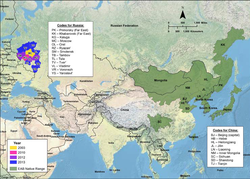Emerald ash borer
The emerald ash borer (Agrilus planipennis or Agrilus marcopoli) is a shiny green beetle native to Asia. It made its way into the United States on accident and has since been spread to eleven states and to the border with Canada.
| Emerald ash borer | |
|---|---|

| |
| Scientific classification | |
| Kingdom: | |
| Phylum: | |
| Class: | |
| Order: | |
| Family: | |
| Genus: | |
| Species: | A. planipennis
|
| Binomial name | |
| Agrilus planipennis Fairmaire, 1888
| |
The beetle is an invasive species, and a serious pest which destroys ash trees. It has killed at least 25 million ash trees so far and threatens to kill most of the ash trees throughout North America.[1]
Adults lay eggs in crevasses in the bark. Larvae burrow into the bark after hatching and consume the living tissue of cambium and phloem. This causes death within two years. The average emerging season for the emerald ash borer is early spring to late summer. Females lay around 75 eggs, but up to 300 from early May to mid-July. The borer's life cycle is estimated to be one year in southern Michigan but may be up to two years in colder regions.
Huge efforts have been made to slow down its spread, but nothing has worked so far. Parasitoid wasps from Asia are being released, and a fungus which kills insects is being tried.[2][3][4]
Emerald Ash Borer Media
A green ash killed by emerald ash borers
A swamp ash with bark stripped by woodpeckers feeding on emerald ash borers
Tetrastichus planipennisi, a parasitoid wasp used as a biological control agent
References
| Wikimedia Commons has media related to Lua error in Module:Commons_link at line 62: attempt to index field 'wikibase' (a nil value).. |
| Wikispecies has information on: Agrilus planipennis. |
- ↑ "EmeraldAshBorer.info". Archived from the original on 2021-09-12. Retrieved 2009-01-18.
- ↑ Gould, Juli; Bauer, Leah, "Biological control of Emerald Ash Borer (Agrilus planipennis)" (PDF), Animal and Plant Health Inspection Service (APHIS) website, United States Department of Agriculture, archived from the original (PDF) on 10 January 2011, retrieved 28 April 2011
- ↑ Bauer, L.S.; Liu, H-P; Miller, D.; Gould, J. (2008). "Developing a classical biological control program for Agrilus planipennis (Coleoptera: Buprestidae), an invasive ash pest in North America" (PDF). Newsletter of the Michigan Entomological Society. 53 (3&4): 38–39. Archived from the original (PDF) on 4 October 2011. Retrieved 29 April 2011.
- ↑ "Biocontrol: Fungus and wasps released to control Emerald Ash Borer". Science News. ScienceDaily. 26 April 2011. Retrieved 27 April 2011.









